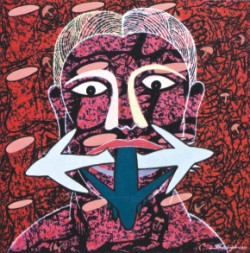| Home - Back Issues - The Team - Contact Us |
 |
| Volume 10 |Issue 17 | April 29, 2011 | |
|
|
Art Clarion Cry against Wars A solo exhibition by Indian artist S K Shahjahan that started on April 23 and ends on May 2 at the Bengal Gallery of Fine Arts, portrays the darker, terrifying side of life Fayza Huq
There is little else but devastation and death. Natural and manmade destructions pervade the universe. In the central installation ‘Headlines’ are popular images such as sunglasses, guns and pistols which are used in case of violence and terrorism. The colours of the hands are sophisticated. One finds sliced off heads. All this is mixed with graffiti, and lines from Bengali news media. A bleeding hand is the focal point of this installation. Gold, black and silver of the creation give it a smooth, gaudy finish. In the centre is the image of a complacent looking moustachioed man. Instead of using monochrome colours, AK Sahajhan has used colours as in average paintings. This centre piece of the display is eye catching, no doubt. "'Red Line' also has images of famine, protest marches; rockets are shown to take off with a bang, and destruction is the message of my work here that covers some years of my labour. The present unrest that grips the world is my focal point. Whatever I've depicted is happening around me," the artist says. He adds, "'Man-woman relationship' is there in some of my works. These I've done before as in the painting depicting a man's affairs with two women at one go. I believe that we are reverting to the primitive times when man did not hesitate to have relationships with more than one woman at a time". The swirling blacks have been used symbolically to show how man ends up by ending under the earth. The viewer feels revolted at the naked figures. Man is shown in his primitive forms in the paintings. "At the same time," Sahajhan says, "I bring in the hotchpotch mélange of the overpopulated cities with their jerry-buildings and crammed unplanned expansions and overcrowdings. This is shown in the miniscule buildings in the backdrop. I've depicted my women as being discontented, and having confused sense of values, and so indulging in lesbianism. They are the defeated protagonists of my drama on canvas."
With the expansion of civilisation nature is being lost. His style has developed with time over about a dozen years. "It's not on purpose. There's not a day I don't work on my canvas. In them I've used mixed media and spray. Unconsciously, my teacher KG Subramanyam and Picasso have influenced my paintings,” he says. In the image taken from “Mahabharata” he has used the repeated image of the ear. He uses repetitions to bring in design and stress on his subject. Doing this again and again, a dimension is created. This is done by green, grey and blue strokes, and is not quite garish as the other paintings. This delineates the birth of the mythical Karna (He was the son of Kunti.) and touches on the theme of man and nature, how one is a part of the other. The black is used to denote how the earth swallows up mankind. Man aims high, but ends up in achieving little to talk about. Scenes from landscapes, the earth, and sky with their perspectives blend with man. In his surrealistic works which reflect contemporary life, violence and terror, the lack of peace and harmony in the 21st century is depicted in all the paintings. They bring in the lack of peace and satisfaction in the present day life. A painting of the young girls, with the broken down buildings around her, depicts the recent turmoil and destruction in Gujrat. The cut face and restless footsteps reflect unhappy humans fleeing from disaster,
In the other paintings, the artist depicts how we enter the world of confusion in everyday life, as we enter a tea-shop and confront a mélange of quixotic worlds where there is no respite. The figures on the canvas are anything but happy or contented. Everything and everyone are wrapped in misery and malaise. Despite the apparent progress in reality there is no true sense of achievement or sense of satisfaction. In the picture done in black and white, with placards bearing the writings “We want peace” there is the clear cry for peace in this world. In a large painting there are clouds of happy dreams of the past. This nostalgia-- the idyllic clouds, the angles and inclusion of jet planes of the present-- depicts present day world in bold, vivid images One of the paintings has painting on the reverse process behind glass, using different colours. Man is repeatedly stressed upon as an integral part of nature. In another there is a city bearing a stark nude female figure. This has been titled “Nude city”. By this the artist means that life is empty and hollow -- a preoccupation of the creative modern world, such as TS Eliot. This gives the subject, a nude female, the appearance of being made of garish pink chewing gum. The image of the cram jammed city in the background, done in tiny details, depicts the unhealthy and ugly modern mega city. Apparently, there is nothing nice in our modern existence.
Copyright
(R) thedailystar.net 2011 |


